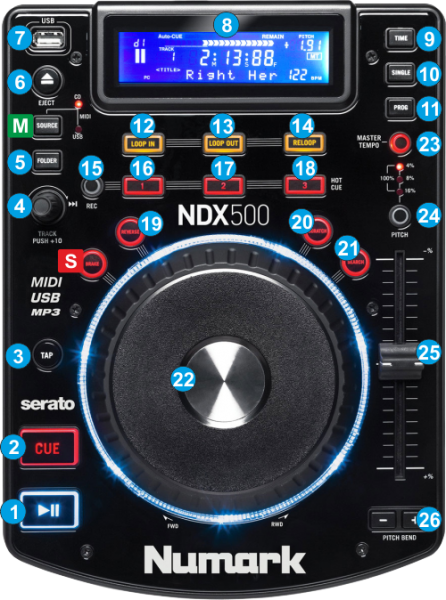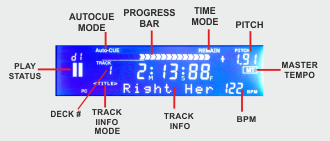NDX 500
CONTROLS

- M SOURCE. Use this button to cycle through the available Operation modes of the Numark NDX500 (CD, USB and MIDI).
If both Leds are on, the unit is set to MIDI mode and can control a VirtualDJ deck. Notice that the unit will still be detected as a MIDI and Audio device if the CD or USB modes are selected, however it will not control any VirtualDJ operation.
S SHIFT. (BRAKE) Press and hold this button to access secondary functions of other controls on the NDX500.
- PLAY. Plays / Pauses the track.
- CUE. When the Deck is paused, you can set a temporary Cue Point by moving the Platter to place the Audio Pointer at the desired location and then pressing the Cue Button.
During playback, you can press the Cue Button to return the track to this Cue Point. (If you did not set a Cue Point, then it will return to the beginning of the track.).
If the Deck is paused, you can press and hold the Cue Button to play the track from the Temporary Cue Point. Releasing the Cue Button will return the track to the temporary Cue Point and pause it. To continue playback without returning to the Temporary Cue Point, press and hold the Cue Button, then press and hold the Play Button, and then release both buttons. - TAP. If the track is paused, use this button to set the 1st beat of the 4-bar Beatgrid to the current position. If track is playing, tap at least 4 times based on the tempo of the track to manually calculate the tempo and the beat phase of the track (if VirtualDJ has not calculated it correctly).
Hold SHIFT down and then use this button to synchronize the tempo and the beat-phase of this track to the opposite (or Master) deck’s track. - TRACK. Use this encoder to scroll through Files or Folders. If focus is on the Folders list, push the encoder to set focus to the Songs list. If focus is on Songs List or Sideview, push the encoder to load the selected track to the deck.
Hold SHIFT down and then use the encoder to cycle through the available views of the Sideview (Automix, Sidelist, Karaoke, Sampler and Shortcuts).
Hold SHIFT down and then push the encoder to cycle through the Browser windows (Folders, Songs and SideView). - FOLDER. Use this button to set focus to the Folders list. If focus is on the Folders list, use this button to open/close subfolders.
- EJECT. Not used. This button selects one of the 4 available MIDI channels of the NDX500. Regardless of the selected MIDI Channel, the NDX500 will still control the assigned VirtualDJ deck.
- USB socket. Connect a USB Flash Drive. Its files will be used when the NDX500 is on USB mode.
- LCD. The LCD screen will show all the Track’s and VirtualDJ Deck information, such as Elapsed/Remain/total times, BPM and pitch, Title, Artist and Album, Play status, assigned Deck number etc.

- TIME. Use this button to cycle through the available Time Display modes (Remain, Elapsed and Total). Each time a Display mode is selected the Time and the mode will be displayed on the LCD screen, and the progress bar will be also adjusted to the selected mode.
- SINGLE. Use this button to enable/disable Automix. An indicator (CONTINUE) will be displayed on the LCD screen if Automix is enabled.
- PROG. Use this button to assign a different VirtualDJ deck to this unit. The number of the assigned deck will be displayed on the LCD screen. The number of the available VirtualDJ decks along with the possible assigned deck on each unit, depends on the total number of the deck son the used GUI or the total number that the connected units can control. Manually assign of a VirtualDJ deck can be made from the Controllers tab of the VirtualDJ Settings window.
By default, if 2 NDX500 are connected and a 4 decks skin is used, the left unit will be assigned to deck 1 and will toggle between decks 1 and 3, and the right unit will be automatically assigned to deck 2 and will toggle between decks 2 and 4.
Hold SHIFT down and then use this button to cycle through the 4 available Text modes on the LCD screen (Title, title-Artist, Artist and Album) - LOOP IN. Use this button to set the Entry point of a manual loop. If a loop is triggered/enabled, use this button to set the Jogwheel to Loop In Adjust mode (led will flash) and then use the Jogwheel to fine-adjust the Loop In point.
Hold SHIFT down and then use this button to half the size of the selected loop. - LOOP OUT. Use this button to set the Exit point of a manual loop. If a loop is triggered/enabled, use this button to set the Jogwheel to Loop Out Adjust mode (led will flash) and then use the Jogwheel to fine-adjust the Loop Out point.
Hold SHIFT down and then use this button to double the size of the selected loop.. - RELOOP. Use this button to exit a manually triggered loop or trigger the last triggered loop (re-loop)
Hold SHIFT down and then use this button to set an Auto Loop of a pre-selected size in beats. - REC. Hold this button down and then press any of the HotCues buttons (16 to 18) to delete their assigned HotCue points (leds will flash).
- HOTCUE 1. Use this button to assign Hot Cue 1 Point or returns the track to this Hot Cue Point. When button is unlit, you can assign Hot Cue 1 by pressing it at the desired point in your track. Once it is assigned, the Hot Cue Button will light. To return to Hot Cue 1, simply press it.
Hold the REC button down and then use this button to delete HotCue 1
Hold SHIFT down and then use this button to trigger an Auto-Loop of 1 beat in size. - HOTCUE 2. Use this button to assign Hot Cue 2 Point or returns the track to this Hot Cue Point. When button is unlit, you can assign Hot Cue 2 by pressing it at the desired point in your track. Once it is assigned, the Hot Cue Button will light. To return to Hot Cue 2, simply press it.
Hold the REC button down and then use this button to delete HotCue 2
Hold SHIFT down and then use this button to trigger an Auto-Loop of 2 beats in size. - HOTCUE 3. Use this button to assign Hot Cue 3 Point or returns the track to this Hot Cue Point. When button is unlit, you can assign Hot Cue 3 by pressing it at the desired point in your track. Once it is assigned, the Hot Cue Button will light. To return to Hot Cue 3, simply press it.
Hold the REC button down and then use this button to delete HotCue 3
Hold SHIFT down and then use this button to trigger an Auto-Loop of 4 beats in size. - REVERSE. Use this button to play the track in reverse. Once disabled, the track will continue to play at the normal direction from the current position. When Slip mode is enabled, the track will return to the position it would have been if the reverse was never used.
- SCRATCH. Use this button to toggle between the CD and Vinyl Jogwheel modes. The Led if this button will be lit if the Vinyl mode is selected.
In CD mode, use the Jogwheel to bend (temporary speed up – slow down the tempo of the track).
In VINYL mode, use the outer part of the Jogwheel to bend (temporary speed up – slow down the tempo of the track) and the inner touch-sensitive part to scratch.
Hold SHIFT down and then use this button to enable/disable Slip mode. When Slip mode is enabled, several functions such as Scratching, loops, HotCues etc. will act temporary and the track will resume to the position it would have been if those functions never used. - SEARCH. Hold this button to set the Jogwheel to temporary set the Jogwheel to Search/Seek mode. While the button is held, use the Jogwheel to fast search/seek through the track. Once released, the Jogwheel will return to its previous mode.
- JOG. Touch sensitive jogwheel. Use the jogwheel to scratch and pitch bend (if Vinyl mode is selected), or pitch bend (in CD mode) If the SEARCH button is pressed, use the Jogwheel to fast search/seek through the track.
The Jogwheel also offers Loop In and Loop Out adjustment (see LOOP IN and LOOP Out buttons) - MASTER TEMPO. Press this button to "lock" the track's pitch to its original key. The track's tempo will remain at the speed designated by the Pitch Fader.
- PITCH RANGE. Press this button to select the next available range for the Pitch Fader (available values ±4%, ±8%, ±16% and ±100%).
The Leds above this button will indicate the selected pitch range.
A different Pitch range can be selected from the Deck Options in VirtualDJ GUI. - PITCH. Adjust the track's playback speed (tempo).
The actual pitch fader will not alter the pitch of the track if the actual pitch and the software pitch value do not match (software soft-takeover, ghost fader visible on the GUI). In most cases this may happen if SYNC is prior pressed or switching decks and the other deck is having a different pitch software value. - PITCH BEND. Press and hold down these buttons to temporary speed up/slow down the song while pressed. When released, the track playback will return to the speed designated by the Pitch Fader.






